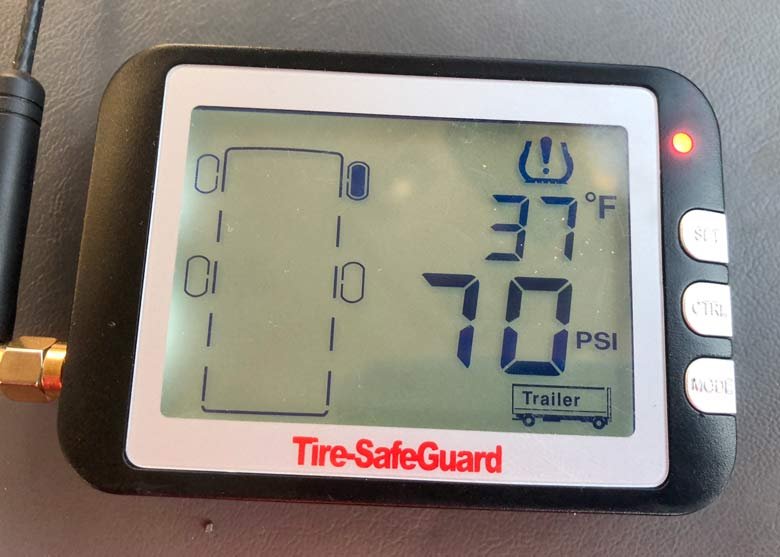The Dreaded TPMS False Alarm
We have plenty of reason to be alarmed when hearing the dreaded BEEP from our Tire Safe-Guard Tire Pressure Monitoring System (TPMS). Ever since our TPMS saved us from much more serious tire and trailer damage on multiple occasions during our RVing to Alaska adventure, we have been a bit jumpy any time we hear the sound
It is important to understand the different alarm sounds, and how to deal with them.

Understanding Audible Tire-SafeGuard TPMS Alarms
What do the different alert sounds mean when you hear the alarm on your Tire-SafeGuard TPMS? Listen carefully…
BEEEEEEEEP!!! Pull over. Immediately. You have a sudden loss in tire pressure, and you are in for a world of hurt if you do not act quickly.
BEEP! BEEP! BEEP! Stop, pay attention. A series of shorter beeps indicates you have a slow leak. Investigate and evaluate the situation ASAP.
BEEP! Did you ignore that series of short beeps? The TPMS will continue to remind you that one of your tires has reached the low pressure setting.
What To Do About TPMS False Alarm
For starters, the alarm is not false.
Your Tire-SafeGuard TPMS will alert you according to the settings you configured when installing each monitor cap. What? You don’t have a TPMS Yet!? Read our Tire-SafeGuard TPMS Review and Installation Tips to understand why you need one, and learn how to set it up.
As I explained in those installation steps, the Low Pressure threshold should be set to -12% of your specified tire pressure. For our Maxxis trailer tires rated at 80 PSI, subtracting 12% (9.6) equals 70.4. To be safe, I rounded that up to 71 PSI. This means anytime our pressure reaches 70 PSI, the TPMS will alert us and indicate which tire is low.

Slow leak, or “false” alarm?
The first time we heard the short beep of the TPMS, we had already been been on the road a while and traveling down a rocky section of the Cassiar Highway. I pulled over to discover an arrowhead shaped rock stuck in the trailer tire, causing a slow leak. No false alarm there! Read about that roadside repair here.
The second time we heard the same short beep was early the morning we left our boondocking spot in the parking lot across from Athabasca Glacier. After everything we had been through, we were justifiably upset. Two tires were showing the slow leak alarm.

After inspecting the tires and reviewing the TPMS monitor readings, I came to this logical conclusion: the cold temperature had caused air inside the tires to compress, resulting in less pressure on the sensors. After driving around the parking lot for a few minutes, we saw the pressure in one of the tires go up, confirming my theory. After about five minutes back on the highway, normal pressure had resumed to all tires.
So, what to do about that TPMS low pressure warning?
1. Don’t panic. Laughter comes in handy at this point.
2. Is it cold out? Look at the temperature reading, compared to the current pressure displayed. Note the first picture above to see how it was nearly freezing when our “false” alarm occurred.
3. Closely inspect any tires indicated on your TPMS for visible damage.
4. Drive carefully for a short period while carefully monitoring your tire pressure monitor. If pressure increases, you are good to go. If pressure continues to drop, this is no false alarm. You know what to do. You know, that thing you never want to do…
5. OPTIONAL: Adjust your TPMS Low Pressure Threshold. Personally, I would much rather deal with these “false” alarms on cold mornings than risk any further drop in pressure before being notified by my Tire-SafeGuard TPMS that I may have any loss in pressure.
Still think you don’t need a TPMS?
Suggested Reading:
[unordered_list style=”arrow”]
- Before RV TPMS, After RV TPMS. There’s No Comparison.
- Tire-SafeGuard TPMS Review and Installation Tips
- Alaska or Bust
- Flat Tire Protection Provides Peace of Mind
[/unordered_list]
Product Recommendation:
[unordered_list style=”star”]
[/unordered_list]
Any questions?
1 thought on “Top TPMS False Alarm Fixes”